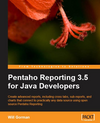Pentaho at Google I/O
I just got back from a great trip to San Francisco, where Mike D. and I represented Pentaho at the Google I/O Sandbox. In addition to getting my free Android phone and playing some serious air hockey, I also got the chance to meet a lot of great people. Mike and I got to meet a many of the folks on the Google Web Toolkit team, and I know they were very happy that they can now talk about the Wave project and their participation in it. I can’t tell you how excited I am about Wave, and also how excited I am for the future of GWT and HTML 5.0.
There are so many great things happening within GWT at the moment, that Mike and I will probably get GWT trunk building so we can start playing with it. This includes dynamic script loading, better hosted mode support, along with fantastic reports to help optimize your GWT compile sizes.
Another surreal moment for me at the conference was when Steven Canvin of Lego showed off the WiigoBot, one of my many Lego robots, on stage during the second key note right before Wave came on. I’m a big fan of lego, so much so that I created the first ever Lego bar chart and presented it during the Sandbox event:
You can find instructions to build your own out on the Pentaho’s Wiki, including having it work with the Pentaho BI Platform!
 Comments(1)
Comments(1)

